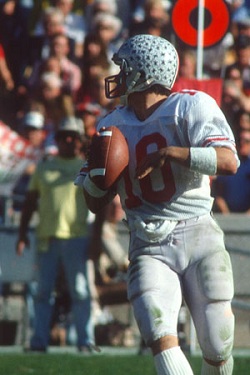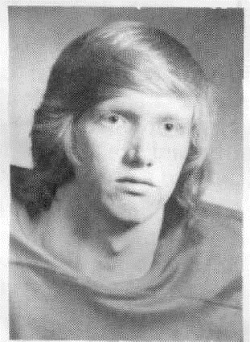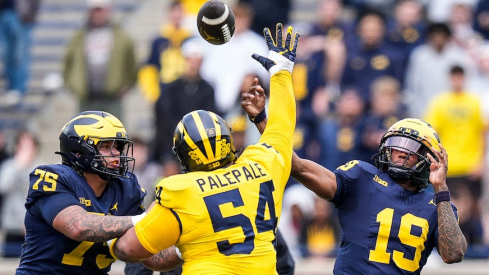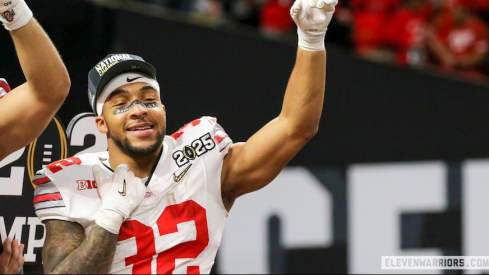 Schlichter finished 6th in the Heisman voting in '80.
Schlichter finished 6th in the Heisman voting in '80.Some seasons begin with cautious optimism, and each win brings the fan expectations up to a fever pitch. Other seasons begin with expectations sky high, and the team struggles to meet them. The 1980 season was of the latter kind, a year when Ohio State was ranked #1 to start the season but almost immediately showed the kind of weaknesses that a top-ranked team cannot have if it is to survive the grind of a long season.
The expectations had been set by the unexpected success of the 1979 team. Earle Bruce was in his first season replacing legendary coach Woody Hayes, and the team had underachieved the previous season. After a rough start, the 1979 team got on a roll and didn't stop rolling until they lost 17-16 to a loaded USC team in the Rose Bowl. Ohio State finished 11-1 for the season, and Bruce was named college football's Coach of the Year.
The biggest star from the 1979 team, QB Art Schlichter, was returning for his junior season, along with his favorite receivers Doug Donley and Gary Williams. Also returning were RB's Calvin Murray, Jim Gayle, and Ricky Johnson. The team also boasted a highly regarded freshman class. In all, OSU returned 15 starters and 41 lettermen from the previous season, and the strong returning contingent is what boosted hopes for fans of the program.
What the casual fan may not have noticed, however, is that one key element of the team was in full rebuilding mode. OSU lost 4 out of 5 starters on the offensive line, and the one guy that returned, Joe Lukens, was a freshman. Not only that, but the top 2 fullbacks were also gone. At Ohio State, the fullback is still an important position for blocking, and it was even more so back in 1980.
And so, the starting offensive line for OSU in 1980 looked like this: now sophomore Lukens slid over from offensive tackle to guard, backup Scott Burris moved to starter at the other guard, undersized backup Jim Deleone moved up to starting center, former DT Luther Henson moved to offensive tackle, and former TE Ron Barwig moved to the other OT. To top it all off, reserve tailback Tim Spencer moved to fullback. At the key blocking positions, Ohio State was starting 4 players who had moved from other positions, two of whom were undersized for their new role.
Ironically, it would be the defense that caused problems for the team in their first game against Syracuse. Middle guard (analogous to nose-tackle) Tim Sawicki had departed and so the position was turned over to Mark Sullivan. However, Sullivan was not allowed to start the opener for disciplinary reasons, and so the start went to Reggie Echols, a natural DT who moved over to take the position. The absence of Sullivan was felt immediately as the Orangemen moved the ball methodically on the ground with RB Joe Morris carrying the load. OSU trailed 21-3 early in the 2nd quarter.
Sullivan ultimately returned and OSU made some other adjustments and went on to win the game 31-21. An easy home contest against Joe Salem's Minnesota Gophers followed and OSU exploded to a 33-0 halftime lead on their way to a 47-0 win. But the offensive line issues reared their ugly head the next week as UCLA came to town. Still smarting after OSU's comeback victory on their turf the previous season, the Bruins arrived with a hefty chip on their shoulders and rolled over the Buckeyes 17-0. Throughout the game, UCLA DT Irv Eatman pushed through OSU's undersized line for sacks and pressures on Schlichter. The junior QB was eventually knocked out of the game with a concussion and backup Bob Atha finished for the Buckeyes. It was a humbling loss, and it brought the first real criticism from fans for Bruce and the coaching staff.
Getting back on the winning track was imperative, and Ohio State did just that the next week with a 63-0 thrashing of Northwestern. But Indiana was coming to town the next week, and the Hoosiers were a much better football program in those days then they are today. Coach Lee Corso had led the team to respectability, and in fact they had an excellent season in 1979. That year IU finished 8-4 and finished at #19 in the AP rankings. The 8 wins included a comeback win over previously-unbeaten BYU in the Holiday Bowl.
Among OSU fans, Corso was notorious for having taken a picture of the scoreboard when his team briefly led Ohio State back in 1976. But this Indiana team was no laughing matter. Led by senior QB Tim Clifford, the Hoosiers were 4-1 on the season and 2-0 on the road, and they were coming off a 24-0 home skunking of the Wisconsin Badgers. Corso had his team fired up and ready to play the Buckeyes, especially since his team had been humiliated 47-0 against OSU the previous season. Entering the game, the two teams were tied for 1st in the Big Ten standings.
 Doug Donley: OSU's leading receiver in '79 and '80.
Doug Donley: OSU's leading receiver in '79 and '80.To counter the lack of power in the middle of the line, Ohio State ran lots of options and other outside runs. The strategy worked well against the Hoosiers as tailback Calvin Murray racked up 224 yards on his 22nd birthday. Murray carried 3 yards for a TD in the 1st quarter, and he burst 37 yards for another TD to seal the game in the 4th. Reserve RB Jim Gayle also had a 20-yard TD run in the 1st half. Vlade Janakievski kicked 2 field goals in support of the offense.
Indiana had been extremely prepared for the game, perhaps a little too prepared. The defense was not as soft as they expected, and reserve safety Rod Gorley picked off two Clifford passes in the 2nd half to thwart the reigning Big Ten MVP's attempt at a comeback. IU trailed only 17-10 at halftime, but the 2nd half failures would haunt them as OSU held on for a 27-17 victory.
The loss would be the beginning of the end for Indiana's Big Ten title hopes. They would go on to lose 3 of their last five, including a humiliating 35-0 loss to Michigan. They would not play in a bowl game nor would they be ranked at the end of the season. Fan appreciation for Corso and his antics began to wane after that.
Ohio State would finish 9-3 on the season, including a 9-3 home loss to Michigan and a 31-19 snatch-defeat-from-the-jaws-of-victory loss to Penn State in the Fiesta Bowl. It would be the first of 6 consecutive 9-3 seasons for Earle Bruce, and it would be the end of his honeymoon as head coach for Ohio State. Throughout his tenure, Bruce would be derided for his conservative play-calling, his failure in big games, and even for his physical appearance. In 1986, the streak would end as OSU went 10-3 with a win in the Cotton Bowl.

